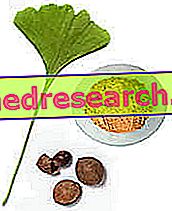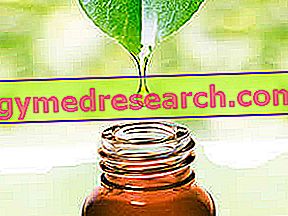See also: Ginkgo Biloba extract in cosmetics
Ginkgo (later ginko) is given by the leaves of Ginkgo biloba, a plant that has its roots in very remote times, since it appeared about 200 million years ago. High up to 30-40 meters, with a trunk that can reach one meter in diameter, Darwin has defined a living fossil, as it is the only specimen belonging to the Ginkgoine family. These plants are an ancient group of high trunk gymnosperms, with a characteristic fan shape, belonging to the Mesozoic era and now extinct for about 100 million years.
The ginko, besides being considered the oldest tree on the face of the Earth, is also one of the longest, since it can reach 1000 years of life. No wonder, then, that in Japan it is considered a sacred tree, often present in the vicinity of the temples. For this reason it is believed that the species has been preserved thanks to the cultivation carried out by Chinese monks to decorate places of worship.
Today, ginko biloba is widespread in the temperate areas of the planet, as an ornamental park plant and as a city avenue; just for this purpose it was introduced in Europe in the mid-eighteenth century.
 | The term "ginkgo" comes from the Japanese Yin-kuo, which means golden apricot; "biloba" refers instead to the shape of the leaf, more or less bilobed. Main indications : venous insufficiency of the lower limbs, disorders of capillary permeability, arterial circulation deficiency, concentration disorders. Positive effects on memory and learning; it is particularly rich in antioxidants that inactivate free radicals ("anti-aging effect"); prevents atherosclerosis and ischemic damage; has anti-inflammatory and neuroprotective properties; useful in the treatment of vertigo and auricular ringing. |
The phytotherapeutic properties of ginko have been known for millennia, but in the western world they have experienced a moment of great popularity only in recent years, thanks to the many virtues attributed to standardized extracts. The parts used for this purpose are the leaves, while the seeds have an external edible part and a heart rich in irritating and toxic substances (such as the alkaloid ginkgotoxin). In eastern markets, ginko pulp and seeds are sold as anthelmintics or wormers (medicines used to fight parasitic worms that are intestinal intolerance).
The main constituents of the leaves are flavonoids (ginko contains flavonoid glycosides such as kampferol, quercetin, isoramnetin, coumaric acid, catechins, proanthocyanidins, etc.), which are particularly known and appreciated for their antioxidant properties. The leaves are also rich in terpenic derivatives (ginkgolides and bilobalide) and ginkgolic acids.
As anticipated, flavonoids neutralize free radicals, currently considered one of the major pitfalls in a state of good health. If produced in excess, due to pollution and incorrect lifestyle, these small molecules accelerate the aging processes and the normal deterioration of the body that accompanies them; they can also favor the appearance of diseases with a significant social weight, such as degenerative diseases and some forms of cancer. Typical components of ginko biloba, but also of many other plants (green tea, centella asiatica, turmeric, milk thistle), flavonoids exert a positive action also at the level of the capillary network, decreasing permeability and increasing the tone of the vessel wall. For these activities, ginkgo leaves and their extracts are used in disorders of the peripheral circulation (varicose veins or varicose veins, cellulite, water retention problems, intermittent claudication ). They are also universally known as a dietary supplement useful for improving mental abilities, thanks to the increase in blood circulation in the brain, which ensures a greater supply of nutrients and a faster elimination of waste. For this purpose, ginko biloba is recommended to young people to increase their abilities and in the elderly as a preventive of Alzhaimer disease and senile dementia.
Ginkgolide B is considered an effective antagonist of PAF (platelet factor), essential for blood coagulation and in inflammatory processes, but it is good to keep it under control in the presence of atherosclerosis and heart and vessel diseases (can favor the formation and the rupture of thrombus and atherosclerotic plaques, causing the risk of suffering serious cardiovascular accidents, such as heart attack and stroke, to soar.
PAF is also a mediator of bronchoconstriction and this explains the traditional use of ginko biloba in the treatment of asthma-like forms.
Ginkgo Biloba - Videos of MypersonaltrainerTv
Watch the video
X Watch the video on youtubeDoses and methods of employment
In western countries, ginko is marketed in the form of standardized extracts (22-27% in flavonoids and 5-7% in terpene derivatives), in the form of drops, capsules or tablets. Dosages are specified on the packages and, for the standardized extracts shown in the example, they range on average from 120 to 240 mg per day, for a duration not less than 8 weeks in the case of chronic pathologies.
Generally, preparations based on ginko biloba contain only leaf extracts, often purified from ginkgolic acids, potentially allergenic and toxic agents.
Side effects
The ingestion of fruits and seeds causes allergic reactions, disorders of the digestive, respiratory and circulatory systems. The seeds, in particular, can cause serious food poisoning, with the appearance of convulsions and loss of consciousness, to the point of even death.
The rare, and in any case mild, side effects of the ginko biloba based products, together with the numerous health properties, have contributed to decree an important commercial success. As a precautionary measure, the Ministry's guidelines explicitly advise against using it during pregnancy and lactation. Since ginko can interfere with blood clotting processes, caution is required when administering anticoagulant drugs, platelet aggregation inhibitors, MAO inhibitors and NSAIDs (aspirin type).



